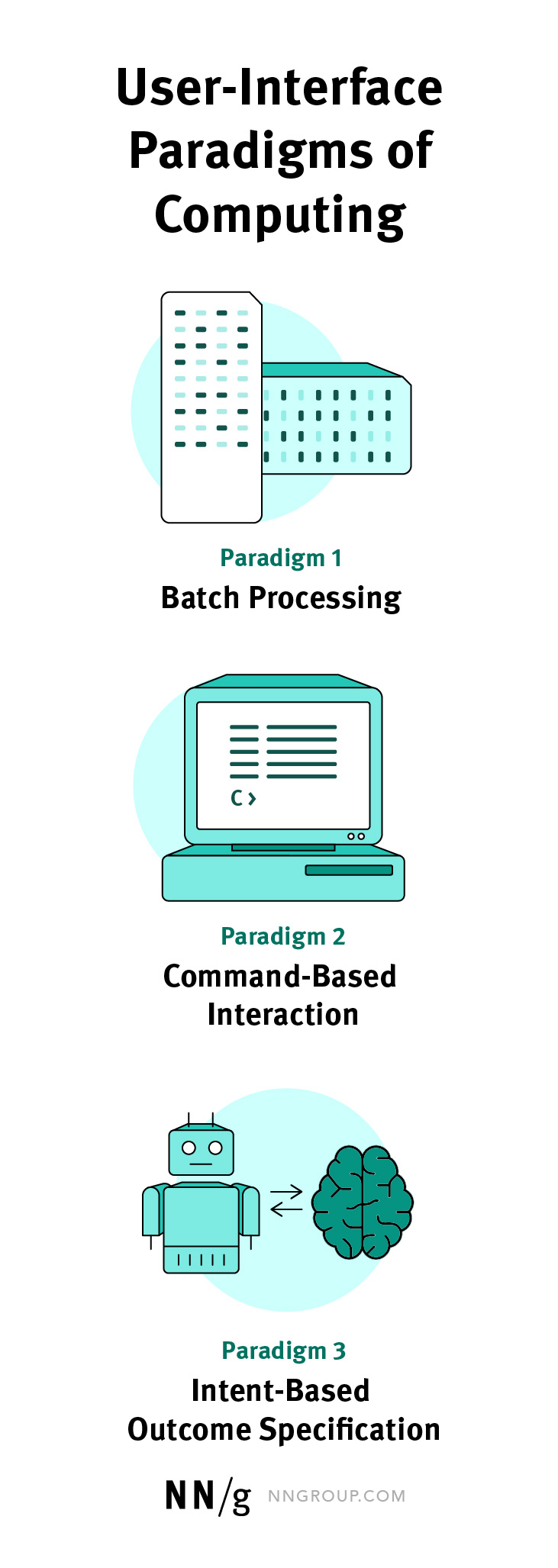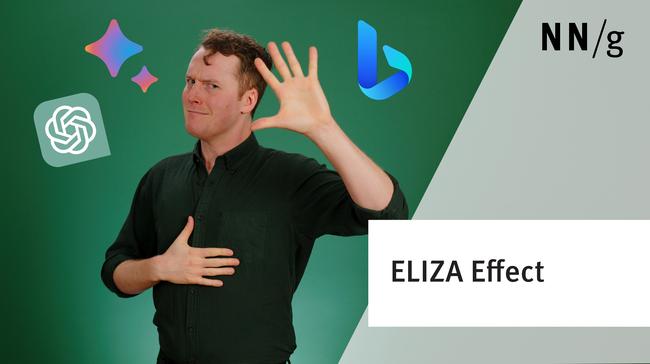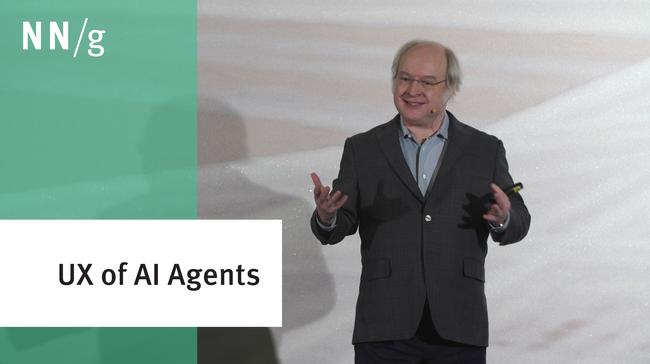ChatGPT and other AI systems are shaping up to launch the third user-interface paradigm in the history of computing — the first new interaction model in more than 60 years.


The First Two Paradigms
Paradigm 1: Batch Processing
From the birth of computers, around 1945, the first UI paradigm was batch processing. In this paradigm, users specified a complete workflow of everything they wanted the computer to do. This batch of instructions was submitted to a data center (often as a deck of punched cards) and was processed at some unspecified time, often overnight.
Later, often the next morning, users would pick up the output of their batch: usually, this would be a thick fanfold of printouts, but it could also be a new deck of punched cards. If the original batch contained even the slightest error, there would be no output, or the result would be meaningless.
From a UI perspective, batch processing did not involve any back-and-forth between the user and the computer. The UI was a single point of contact: that batch of punched cards. Usability was horrible, and it was common to need multiple days to finetune the batch to the point where executing it would produce the desired end result.
Paradigm 2: Command-Based Interaction Design
Around 1964, the advent of time-sharing (where multiple users shared a single mainframe computer through connected terminals) led to the second UI paradigm: command-based interaction. In this paradigm, the user and the computer would take turns, one command at a time. This paradigm is so powerful that it has dominated computing ever since — for more than 60 years.
Command-based interactions have been the underlying approach throughout three generations of user-interface technology: command lines (like DOS and Unix), full-screen text-based terminals (common with IBM mainframes), and graphical user interfaces (GUI: Macintosh, Windows, and all current smartphone platforms). Powerful and long-lasting indeed.
The benefit of command-based interactions compared to batch processing is clear: after each command has been executed, the user can reassess the situation and modify future commands to progress toward the desired goal.
In fact, users don’t even need to have a fully specified goal in mind because they can adjust their approach to the problem at hand as they get more information from the computer and see the results of their initial commands. (At least, that’s the case if the design follows the first of the 10 usability heuristics: visibility of system status.) Early command-line systems often didn’t show the current state of the system, with horrible usability as a result. For example, in Unix, no news was good news because you would get feedback from the computer only if your command resulted in an error message. No errors meant no information from the computer about the new state, which made it harder for users to compose the following command.
The beauty of graphical user interfaces is that they do show the status after each command, at least when designed well. The graphical user interface has dominated the UX world since the launch of the Macintosh in 1984: about 40 years of supremacy until it possibly is replaced by the next generation of UI technology and, more importantly, the next UI paradigm in the form of artificial intelligence.
The Newest Paradigm
Paradigm 3: Intent-Based Outcome Specification
I doubt that the current set of generative AI tools (like ChatGPT, Bard, etc.) are representative of the UIs we’ll be using in a few years, because they have deep-rooted usability problems. Their problems led to the development of a new role — the “prompt engineer.” Prompt engineers exist to tickle ChatGPT in the right spot so it coughs up the right results.
This new role reminds me of how we used to need specially trained query specialists to search through extensive databases of medical research or legal cases. Then Google came along, and anybody could search. The same level of usability leapfrogging is needed with these new tools: better usability of AI should be a significant competitive advantage. (And if you’re considering becoming a prompt engineer, don’t count on a long-lasting career.)
The current chat-based interaction style also suffers from requiring users to write out their problems as prose text. Based on recent literacy research, I deem it likely that half the population in rich countries is not articulate enough to get good results from one of the current AI bots.
That said, the AI user interface represents a different paradigm of the interaction between humans and computers — a paradigm that holds much promise.
As I mentioned, in command-based interactions, the user issues commands to the computer one at a time, gradually producing the desired result (if the design has sufficient usability to allow people to understand what commands to issue at each step). The computer is fully obedient and does exactly what it’s told. The downside is that low usability often causes users to issue commands that do something different than what the users really want.
With the new AI systems, the user no longer tells the computer what to do. Rather, the user tells the computer what outcome they want. Thus, the third UI paradigm, represented by current generative AI, is intent-based outcome specification.
A simple example of a prompt for an AI system is:
Make me a drawing suitable for the cover of a pulp science-fiction magazine, showing a cowboy in a space suit on an airless planet with two red moons in the heavens.
Try ordering Photoshop circa 2021 to do that! Back then, you would have issued hundreds of commands to bring forth the illustration gradually. Today, Bing Image Creator made me four suggested images in a few seconds.

With this new UI paradigm, represented by current generative AI, the user tells the computer the desired result but does not specify how this outcome should be accomplished. Compared to traditional command-based interaction, this paradigm completely reverses the locus of control. I doubt we should even describe this user experience as an “interaction” because there is no turn-taking or gradual progress.
That said, in my science-fiction–illustration example, I’m not happy with the space suits. This might be fixed by another round with the AI. Such rounds of gradual refinement are a form of interaction that is currently poorly supported, providing rich opportunities for usability improvements for those AI vendors who bother doing user research to discover better ways for average humans to control their systems.
Do what I mean, not what I say is a seductive UI paradigm — as mentioned, users often order the computer to do the wrong thing. On the other hand, assigning the locus of control entirely to the computer does have downsides, especially with current AI, which is prone to including erroneous information in its results. When users don’t know how something was done, it can be harder for them to identify or correct the problem.
The intent-based paradigm doesn’t rise to the level of noncommand systems, which I introduced in 1993. A true noncommand system doesn’t require the user to specify intent because the computer acts as a side effect of the user’s normal actions.
As an example, consider unlocking a car by pulling on the door handle: this is a noncommand unlock because the user would perform the same action whether the car is locked or unlocked. (In contrast, a car operated by voice recognition could unlock the door because the user stated, “I want the car to be unlocked,” which would be an intent-based outcome specification. And an old-fashioned car could be operated by the explicit command to unlock the door by inserting and twisting the key.)
Whether AI systems can achieve high usability within the intent-based-outcome-specification paradigm is unclear. I doubt it because I am an enthusiastic fan of graphical user interfaces. Visual information is often easier to understand and faster to interact with than text. Could you fill out a long form (like a bank-account application or a hotel reservation) by conversing with chatbot — even one as smart as the new generative AI tools?!
Clicking or tapping things on a screen is an intuitive and essential aspect of user interaction that should not be overlooked. Thus, the second UI paradigm will survive, albeit in a less dominant role. Future AI systems will likely have a hybrid user interface that combines elements of both intent-based and command-based interfaces while still retaining many GUI elements.




